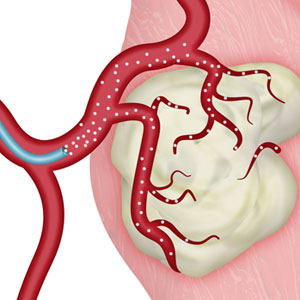What Are Uterine Fibroids?
- Uterine fibroids are benign (non-cancerous) tumors that grow on or within the lining of the uterus.
- They can range in size from as small as a grape to as large as a cantaloupe.
- Approximately 20-40% of women over age 35 have fibroids.
- African-American women are three times more likely to develop them.
Fibroids can result in pelvic pain or discomfort, urinary incontinence, frequent urination and heavy menstrual bleeding. The location and size of uterine fibroids can affect the severity of these symptoms and impact your quality of life. Fibroids are also hormonally sensitive, so the symptoms can be cyclical, just like with menstruation.
What are My Treatment Options?
If your fibroids are not causing pain or other symptoms, treatment is not necessary. Your OB/GYN might wish to monitor their growth during annual examinations. If symptoms are more severe, options include:
- Hormone treatment medication. This can help relieve symptoms such as heavy menstrual bleeding and pelvic pressure, but cannot eliminate fibroids. Medication can also cause side effects, such as weight gain, vaginal dryness and infertility.
- Surgery, in the form of hysterectomy (removal of the entire uterus) or myomectomy (removal of fibroids from within the uterus) are options that are used today. However, surgery is expensive, requires a long and sometimes painful recovery and results in scarring. Myomectomy is the preferred treatment for women who wish to become pregnant, and/or to improve their chances for becoming pregnant.
- Uterine fibroid embolization (UFE). This less invasive, FDA-approved and highly effective approach for treating fibroids is performed by a specialized doctor called an interventional radiologist, who uses X-ray imaging to guide a catheter through the femoral artery in the groin to the uterine artery. When the catheter has reached the location of the fibroids, the radiologist embolizes or “blocks” the blood vessels that feed the fibroid, depriving it of oxygenated blood. The fibroid then shrinks and the symptoms gradually disappear.
UFE is performed on an outpatient basis. The procedure takes less than an hour, and the patient may return home less than 24 hours after the procedure.

If you have questions and would like to speak with a member of our staff, please call the location most convenient for you.
Is UFE Right for Me?
You may be a candidate for uterine fibroid embolization if you:
- Are experiencing the symptoms of uterine fibroids
- Are not or no longer wish to become pregnant
- Are seeking an alternative to hysterectomy (removal of the uterus)
- Wish to avoid surgery or are a poor candidate for surgery
It is not known the long term effects that UFE has on a woman’s ability to become pregnant. If you decide on UFE, becoming pregnant in the future can be extremely difficult; although some women have had successful pregnancies after UFE. As with all medical procedures, talk to your doctor if you have questions, and to help determine if UFE is right for you.
For more information visit RadiologyInfo.org
After the UFE Procedure: What to Expect, Success Rate, and Benefits
What to expect after a uterine fibroid embolization
After uterine fibroid embolization, many patients experience less bleeding than before during their next menstrual cycle.
What is the success rate of UFE?
The satisfaction and success rate for this minimally-invasive procedure is considerably high at 90%, with 70% of Synergy Radiology patients have stated their bleeding during their menstrual cycle and shrinking or complete loss of their uterine fibroids. Patients will typically be able to return to normal activities quickly after the procedure.
Benefits of UFE
Another great benefit of UFE is that a considerably low number of patients experience complications after their Uterine Fibroid Embolization. A minimal number of patients at Synergy Radiology had to undergo another procedure due to remaining symptoms between 6 months to a year after the initial treatment.
UFE Treatment at Synergy Radiology Associates
Treatment options for uterine fibroids Before seeking uterine fibroids treatment, you must talk to your gynecologist or healthcare provider. If you have been diagnosed, there are many different invasive, minimally-invasive, and non-invasive options for patients. At Synergy Radiology, we offer the minimally-invasive uterine fibroid embolization (UFE) procedure. If you have been diagnosed with uterine fibroids, or if you think you may have them call us at 713-358-0600.
